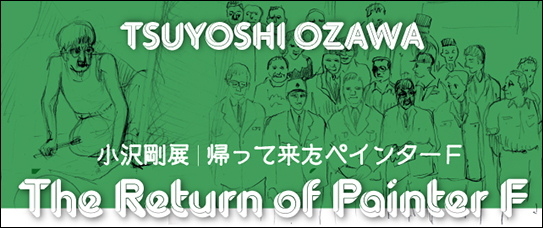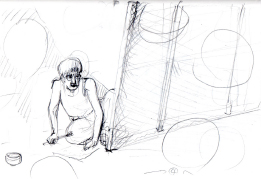Past Exhibition

The Shiseido Gallery is pleased to announce that it will host an exhibition by artist Tsuyoshi Ozawa, titled “The Return of Painter F,” to run from October 23 (Fri) through December 27 (Sun), 2015.
Active both in Japan and abroad, Tsuyoshi Ozawa is known for applying his refined sensibility and creativity to create works rich in humor and wisdom, often based on examinations of particular times, places, and histories. In 2013, at Festival Tokyo, he presented an exhibition-style performance based on Elfriede Jelinek's play “No Light (Prologue?),” and since then has become one of Japan's most acclaimed international artists.
This year, exhibitions exploring the relationship between war and art are being held around Japan. The Shiseido Gallery, opened in 1919, was itself closed for a time due to wartime conditions, although it was still exhibiting as late as December 1944, continuing its mission to proclaim the value of peace and beauty as best it could even in those difficult times. In the 70th year of the end of World War Two, Ozawa now presents an exhibition of new works created around the theme of the Japanese artists active during that wartime period.
In 2013, for an exhibition associated with the 5th Tokyo International Conference on African Development (TICADV), Ozawa presented an installation exhibit titled “The Return of Dr. N,” which was inspired by the connections between Fukushima and Africa. At the core of this was the story of Fukushima-born infectious disease researcher Hideyo Noguchi, whom Ozawa fictionalized in his work as “Dr. N.” The paintings and video comprising that installation were done in collaboration with local banner painters and musicians of Ghana, the country where Noguchi spent his final years researching yellow fever.
This exhibition will be the second in Ozawa's “The Return of…” series, again using paintings and video to create a fictionalized story of the pre-war and post-war life of “Painter F,” a Japanese painter who served in Indonesia during the war. In 1943, the Japanese military occupying Indonesia established the Culture Center aimed at pacifying the local population. Art education was among the activities at these, and it has been said that this had some influence on the subsequent post-war development of the Indonesian art world.
To develop his story for this exhibition, Ozawa began by researching the actual Japanese war painters. He used archival documents and other research materials to create a multi-perspective dialog that includes not only the Japanese point of view, but also the view of Indonesian art historians, painters, and musicians—a process that became collaborative throughout, from story development to the creation and completion of the final work.
It might be worth considering the similarities between the diverse systems of value that characterize our modern age and the situation of Painter F, who during the war years was obliged to move in step with a single point of view but after the war experienced a radical turn of mind. And, in our increasingly globalized world, for people living in Japan and Indonesia looking back on history with a reciprocal perspective, the act of creating a work that imagines “a past that might have been” may be a good way to deepen knowledge and understanding of the other, thus becoming a call for future new creativity and connection.
Shiseido's corporate mission of “we inspire a life of beauty and culture”, through communication with others, makes it possible to recognize a diversity of beauty. Ozawa's works, which stimulate thought in a way that transcends era, borders, and generations, we hope will sow seeds of new intercultural communication.
Tsuyoshi Ozawa Profile
Born in Tokyo in 1965. Currently lives in Saitama, Japan. Earned master's degree from the Department of Fine Arts of the Graduate School of Tokyo National University of Fine Arts and Music (majoring in mural painting) in 1991. Ozawa's notable works include: his “Jizoing” series, in which he photographs statues of homemade Jizo statues situated in different environments; his Nasubi Gallery series of portable micro-galleries made from milk boxes; his “Museum of Soy Sauce Art,” in which he re-paints historical Japanese art masterpieces using soy sauce; and his “Vegetable Weapon” series of photographic portraits of young women holding “weapons” made of vegetables. In 2007, Ozawa teamed with Chinese artist Chen Shaoxiong and Korean artist Gimhongsok to form “The Xijing Men,” an artistic collaboration that explored themes related to breaking communication barriers. Selected major solo exhibitions include: “Answer with Yes and No!” (2004) at the Mori Art Museum, Tokyo; “The Invisible Runner Strides On” (2009) at the Hiroshima City Museum of Contemporary Art; and “Tsuyoshi Ozawa: As you love a certain somebody, somebody loves some else, too” (2012) at the Fukushima Prefectural Museum of Art and the Toyota Municipal Museum of Art. Ozawa was the recipient of the 25th Takashimaya Art Award from the Takashimaya Culture Foundation.
■Reference Images




■Exhibition Details for “Tsuyoshi Ozawa The Return of Painter F”
| Sponsor : | Shiseido Co., Ltd. |
| Duration : | October 23 (Fri) to December 27 (Sun), 2015 |
| Venue : |
Shiseido Gallery Ginza Shiseido Building, B1, 8-8-3 Ginza, Chuo-ku, Tokyo 104-0061 Tel:03-3572-3901; Fax:03-3572-3951 |
| Hours : |
Weekdays 11:00 AM - 7:00 PM, Sunday & National Holidays 11:00 AM - 6:00 PM Closed Mondays (including public holidays) |
| Admission is free | |